Welcome to 2025, where artificial intelligence isn’t just a futuristic concept—it’s your new favorite assistant, ready to revolutionize your daily routine. If you’ve ever wondered how to integrate AI for everyday tasks without needing a computer science degree, you’re in the right place. This guide will walk you through practical, easy-to-implement ways to use AI to boost your productivity, manage your personal life, and even spark creativity.
Forget complex jargon and intimidating interfaces. We’re focusing on user-friendly tools and providing you with concrete, copy-paste-ready prompts to ensure immediate success. From organizing your schedule to planning healthy meals, AI can be a truly transformative companion. Let’s embark on this journey from basic automation to more advanced, creative AI use, making the learning curve feel manageable and incredibly rewarding.
Key Takeaways:
- AI is now accessible for everyone, making daily tasks easier and boosting productivity.
- Learn specific ‘how-to’ prompts for popular AI tools like ChatGPT/Gemini to get instant results.
- Beyond work, AI can revolutionize personal life management: meal planning, budgeting, and learning.
- Understand key criteria to choose the right AI tool for your specific needs, including free vs. paid options.
- Be aware of common pitfalls like AI hallucinations and privacy concerns, and learn how to navigate them responsibly.
- A ‘Quick Start’ checklist provides immediate actions to integrate AI into your routine today.
The Rise of Your Personal AI Companion
Artificial Intelligence has moved beyond niche tech circles and into our homes and pockets. Virtual assistants like Siri and Alexa have been a part of our daily lives for years, but today’s AI offers far more sophisticated capabilities. Imagine an assistant that can draft emails, summarize lengthy reports, or even help you brainstorm creative ideas in seconds. This isn’t just about saving time; it’s about offloading mental clutter and empowering you to focus on what truly matters.
Why AI Isn’t Just for Tech Geniuses Anymore
The beauty of modern AI tools is their accessibility. Many are designed with intuitive interfaces, requiring no coding or advanced technical skills. Whether you’re a student, a busy professional, or simply looking to streamline household chores, there’s an AI tool perfectly suited for your needs. The focus has shifted from complex algorithms to practical applications that anyone can master. This democratization of AI is a key reason why it’s becoming an essential skill in 2025 and beyond.
Essential AI Tools for Beginners (and How to Use Them)
Getting started with AI for everyday tasks means picking the right tools. Here are some beginner-friendly options and practical prompts to kickstart your journey:
1. ChatGPT or Google Gemini: Your All-Purpose AI Assistant
These large language models (LLMs) are incredibly versatile, acting as brainstorming partners, writers, and researchers. Google offers Google AI Essentials for beginners, which includes hands-on training with tools like Gemini. For a deep dive into advanced models, you might also find value in an ultimate guide to GPT-4o.
- Task: Plan a Healthy Weekly Meal Prompt: “Act as a nutritionist and meal planner for a family of four, including two young children. Create a 5-day dinner meal plan (Monday-Friday) that is balanced, includes varied protein sources (chicken, fish, vegetarian), and takes no more than 45 minutes to prepare each evening. Avoid peanuts and shellfish due to allergies. Generate a corresponding grocery list organized by supermarket aisle (produce, dairy, pantry, meat/fish).” (AI will generate meal ideas and an organized shopping list, simplifying your week.)
- Task: Summarize a Long Article or Document Prompt: “Summarize the following article in 5 bullet points, focusing on the key arguments and main takeaways. Keep each bullet point concise: [Paste article text here].” (Perfect for quickly grasping essential information without reading through lengthy content.)
- Task: Organize a Trip Itinerary Prompt: “I’m planning a 7-day trip to London for two adults in September 2025. We enjoy history, good food, and theater. Suggest a daily itinerary that includes 2-3 main attractions per day, restaurant recommendations (mid-range budget), and a evening activity. Factor in travel time between locations. Suggest a day trip outside London if feasible.” (AI can help you build a comprehensive plan, saving hours of research.)
2. Grammarly: Your Writing Co-Pilot
This AI-powered writing assistant goes beyond grammar checks. It helps improve clarity, tone, and conciseness in your emails, reports, and social media posts.
- How to Use: Install the browser extension or desktop app. As you type in any application, Grammarly provides real-time suggestions for grammar, spelling, punctuation, clarity, and even offers to rephrase sentences for better impact. (Elevate your communication instantly, whether for work or personal messages.)
3. Otter.ai: Never Miss a Word
Otter.ai transcribes spoken conversations into text in real-time, making meetings, interviews, or lectures easily reviewable and searchable.
- How to Use: Record a meeting directly in the app or upload an audio file. Otter.ai processes the audio and provides a transcript, highlighting different speakers. You can then search for keywords, edit, and share the transcript. (Ideal for students, journalists, or anyone who attends numerous online meetings.)
4. Canva Magic Design: Creative Design Made Easy
Canva integrates AI to help you create stunning visuals, from social media graphics to presentations, without needing design skills. This can be especially useful for those interested in AI tools for content creation.
- How to Use: Start with a “Magic Design” prompt, describing what you want (e.g., “A social media post about a summer sale for a clothing brand”). Canva’s AI will generate various design options, which you can then customize with your text, images, and brand colors. (Quickly design professional-looking graphics for personal projects or small businesses.)
5. Notion AI / Todoist: Intelligent Organization
Tools like Notion AI and Todoist integrate AI to help manage tasks, organize notes, and streamline workflows.
- Notion AI Prompt: “Act as a project manager. Generate a project brief for planning a home renovation, including sections for scope, budget, timeline (3 months), key stakeholders, potential risks, and a task breakdown for each phase (demolition, framing, plumbing, electrical, finishing). Suggest a weekly check-in agenda.” (Notion AI can structure complex projects, saving you setup time and ensuring comprehensive planning.)
- Todoist AI Scheduling: Use natural language to add tasks (e.g., “Email Sarah about project update next Tuesday”). Todoist’s AI understands and schedules it. Many AI task managers like Motion also offer intelligent scheduling, optimizing your day automatically. (Keep your to-do list organized and prioritized with minimal manual effort.)
Beyond Work: Unleashing AI’s Power in Your Personal Life
AI for everyday tasks extends far beyond professional productivity. It’s an excellent tool for enhancing your personal well-being and managing your household.
Meal Planning & Grocery Lists
AI can transform meal prep from a chore into a seamless process.
- Prompt: “Generate a 7-day vegetarian meal plan for someone looking to reduce calorie intake to approximately 1800 calories per day. Include breakfast, lunch, dinner, and two snacks. Ensure a variety of vegetables and plant-based protein. Create a consolidated grocery list.” (This prompt goes beyond the previous simple meal plan, incorporating dietary goals and a more complex structure.)
Fitness & Wellness Tracking
Many fitness apps now use AI to personalize workout plans, track progress, and suggest adjustments based on your performance and goals. Some smartwatches and fitness trackers leverage AI to analyze sleep patterns, heart rate variability, and stress levels, offering personalized recovery recommendations.
Budgeting & Personal Finance
AI-powered financial apps can help you manage your money, track expenses, and identify savings opportunities.
- Prompt: “Act as a personal finance advisor. Analyze my monthly spending habits based on the following categories (Rent: £1200, Groceries: £400, Eating Out: £300, Transport: £150, Utilities: £100, Entertainment: £250, Savings: £100). Identify areas where I can realistically cut back to save an additional £200 per month without significantly impacting quality of life. Provide actionable tips.” (Tools like Mint or Cleo use AI to automatically categorize transactions and offer personalized insights.)
Learning New Skills
AI can act as a personalized tutor, providing tailored learning paths and resources.
- Prompt: “I want to learn the basics of digital photography. Create a 4-week learning roadmap for a beginner, including topics to study each week (e.g., camera settings, composition, lighting), suggested practical exercises, and free online resources (websites, YouTube channels). Assume I have a basic DSLR camera.” (AI can structure your learning, making it more efficient and engaging.)
Smart Home Management
AI integrates with smart home devices (like Google Assistant or Amazon Alexa) to automate routines, manage energy consumption, and enhance security, making your home life smoother.
Choosing the Right AI Tool: A Quick Guide
With a booming market, selecting the best AI tool for your specific needs is crucial. Here’s what to consider:
Criteria for Evaluation:
- Purpose & Problem-Solving: What specific problem are you trying to solve? Avoid tools that are “solutions looking for problems.”
- Ease of Use: For beginners, an intuitive interface and clear documentation are paramount. Look for tools with minimal setup and a gentle learning curve.
- Cost: Many tools offer free tiers or trials. Start with these to experiment before committing to a paid subscription.
- Integration: Does it work seamlessly with other tools you already use (e.g., Google Workspace, Microsoft 365)?
- Accuracy & Reliability: While AI can “hallucinate” (make up information), reliable tools offer higher accuracy. Always fact-check critical outputs.
- Privacy & Security: Understand how your data is used and protected, especially for sensitive information.
- Scalability: Can the tool grow with your needs, offering more advanced features as you become proficient?
Comparison Table: Popular Beginner-Friendly AI Tools (2025)
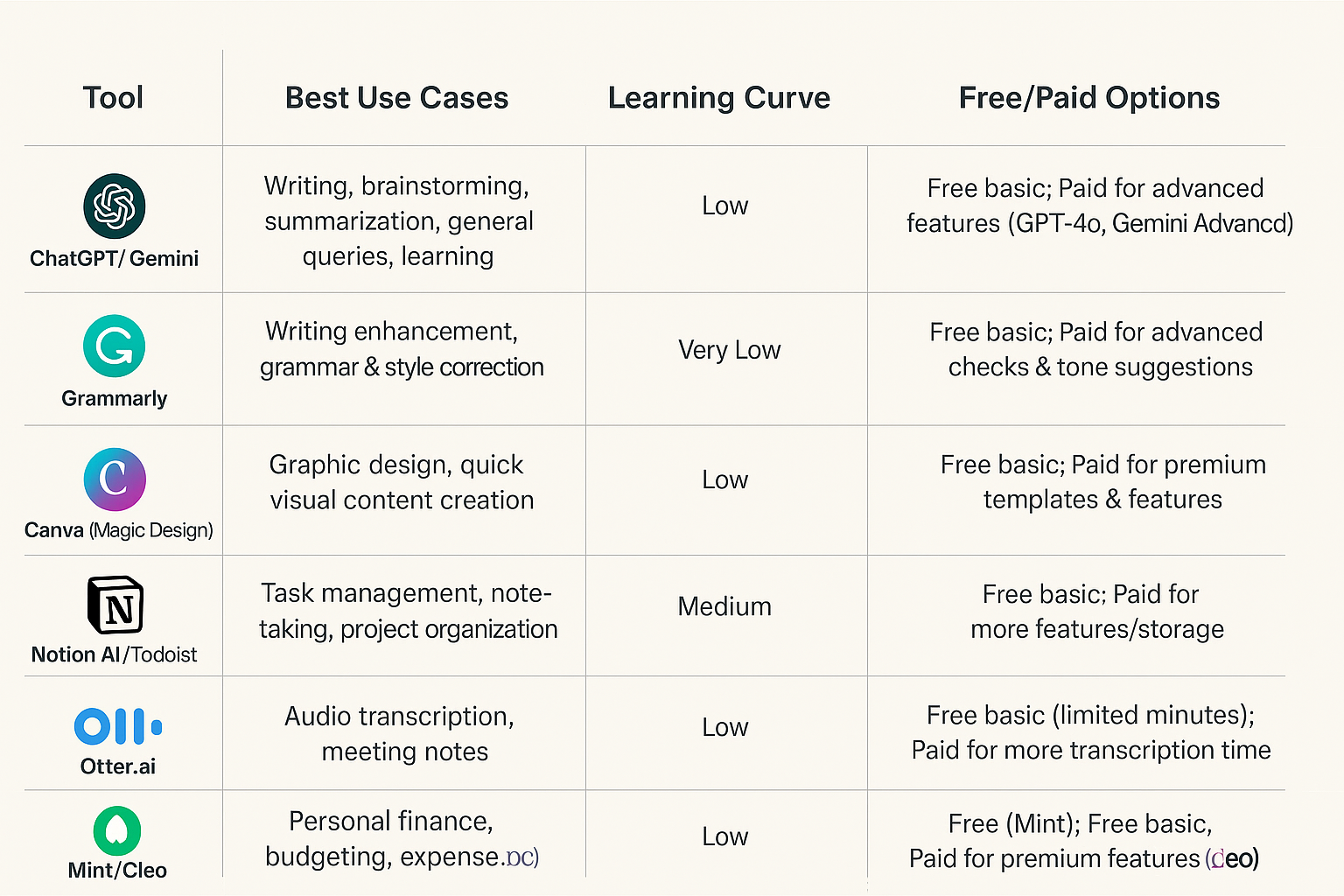
Avoiding Common AI Pitfalls: A Beginner’s Survival Guide
While AI is powerful, it’s not foolproof. Being aware of potential issues will help you use it more effectively:
- AI Hallucinations: AI models can sometimes generate plausible-sounding but entirely false information. Always fact-check critical outputs, especially for factual or numerical data.
- Privacy Concerns: Be cautious about inputting sensitive personal or confidential information into public AI tools. Understand their data retention and usage policies. Your data privacy and security are paramount.
- Over-Reliance & Loss of Critical Thinking: Don’t let AI do all your thinking. Use it as an assistant to augment your abilities, not replace them. Continuously review and refine AI outputs to maintain your unique voice and judgment.
- Bias in AI: AI models learn from data, and if that data contains biases, the AI can perpetuate them. Be mindful that AI outputs might reflect societal biases.
- Ethical Considerations: The responsible use of AI is a growing concern. Consider the broader impact of AI, not just its convenience. This extends to personal well-being; it’s important to foster a balanced relationship with technology. For more on the human element, you might be interested in topics such as World Mental Health Day 2025, which often highlights the importance of human connection and mental well-being alongside technological advancements.
- Ignoring Setup Time: Automation tools save time, but they require initial setup. Plan to spend a few minutes learning how to use new tools effectively.
Your Quick Start AI Checklist: Act Now!
Ready to integrate AI for everyday tasks? Here’s how to start today:
- Pick One Task: Choose a single recurring task that takes up too much time (e.g., email drafting, meal planning, summarizing articles).
- Select One Tool: Start with a free, beginner-friendly tool like ChatGPT/Gemini or Grammarly.
- Try a Prompt: Use one of the copy-paste prompts provided in this guide, adapting it to your needs.
- Review & Refine: Examine the AI’s output. How could you make your prompt better for the next time? Edit the AI’s response to match your style.
- Repeat & Expand: Once comfortable, tackle another task or explore a new AI tool.
Conclusion: Your AI Journey Starts Today
Embracing AI for everyday tasks doesn’t require you to be a tech guru. It’s about taking small, actionable steps to integrate intelligent assistance into your life. By understanding the tools available, crafting effective prompts, and being mindful of potential pitfalls, you can unlock significant gains in productivity, organization, and even creativity.
The landscape of AI is constantly evolving, offering exciting opportunities for personal and professional growth. Staying informed, perhaps by following a reputable tech blog, and continuously experimenting will ensure you harness its full potential responsibly. Start your AI journey today—your future, more efficient self will thank you!
Frequently Asked Questions (FAQ)
Q1: What are the easiest AI tools for beginners to use daily?
For beginners, tools like ChatGPT or Google Gemini (for general assistance, writing, and brainstorming), Grammarly (for writing), Canva’s Magic Design (for simple graphic design), and Todoist (for task management) are incredibly user-friendly and require no coding expertise. Many offer robust free versions to get you started.
Q2: How can AI help with personal tasks beyond work?
AI can significantly aid personal life management through tasks like creating personalized meal plans and grocery lists, tracking fitness and wellness goals, assisting with budgeting and personal finance analysis (e.g., Mint, Cleo), generating structured learning roadmaps for new skills, and even automating smart home devices.
Q3: What are some effective prompts for AI tools like ChatGPT?
Effective prompts provide context, define a role for the AI, and clearly state your goal. Examples include: “Act as a nutritionist and create a 5-day healthy dinner plan for a family of four, avoiding peanuts. Generate a grocery list.” or “Summarize this article in 5 bullet points, focusing on key arguments.” The more specific you are, the better the AI’s response will be.
Q4: How do I choose the right AI tool for a specific problem?
When choosing an AI tool, consider its specific purpose, ease of use for beginners, cost (many have free tiers), and integration with your existing software. Always evaluate a tool’s accuracy, data privacy policies, and how well it scales with your needs.
Q5: What are common pitfalls when using AI for the first time?
Common pitfalls for beginners include AI “hallucinations” (generating false information), privacy concerns (inputting sensitive data), over-reliance that dulls critical thinking, and bias present in AI outputs. Always fact-check crucial information, be mindful of data privacy, and use AI as an augmentation tool rather than a replacement for human judgment.
Q6: Are there any ethical considerations I should be aware of when using AI?
Yes, ethical considerations are crucial. These include ensuring fairness in AI systems, protecting data privacy, understanding potential biases, and maintaining human oversight. It’s important to use AI responsibly and be aware of its societal and personal impacts, including how it influences mental well-being and decision-making.
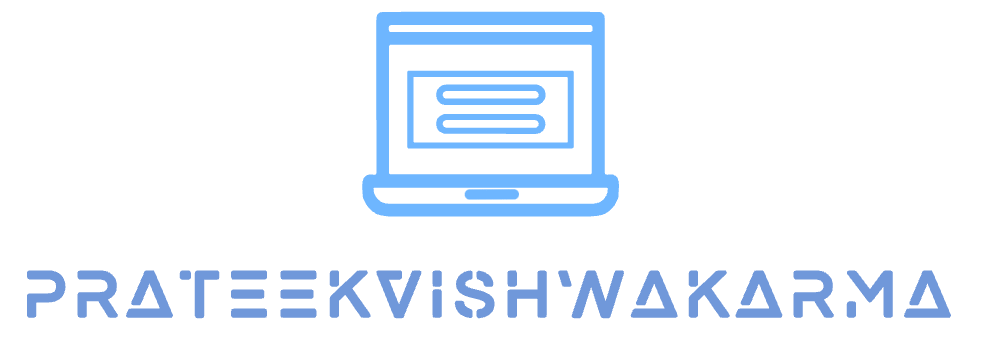







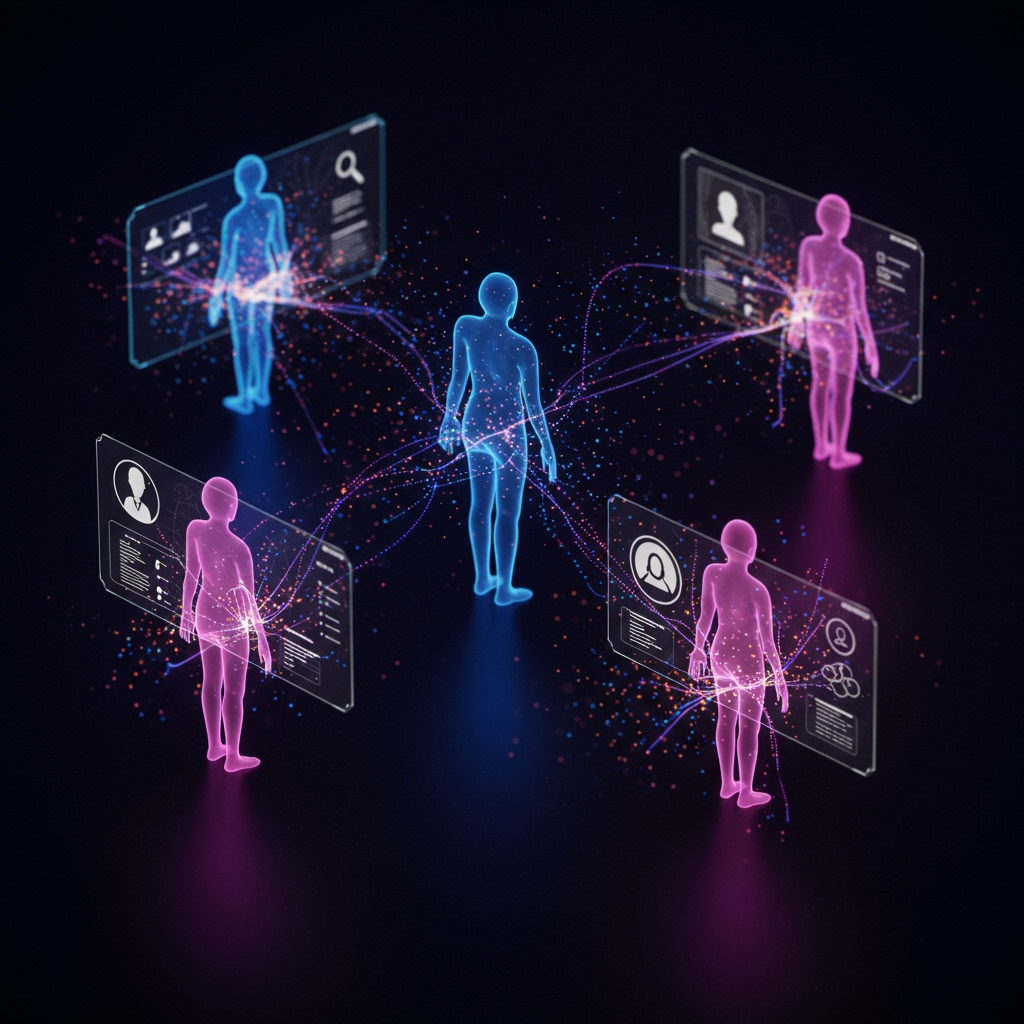

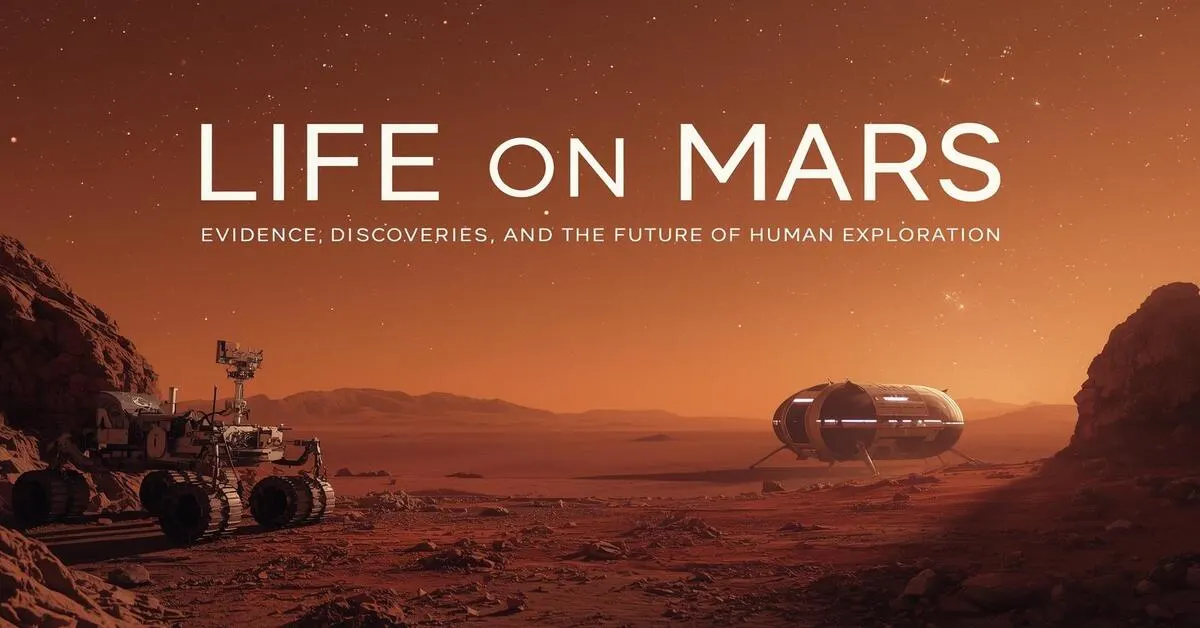


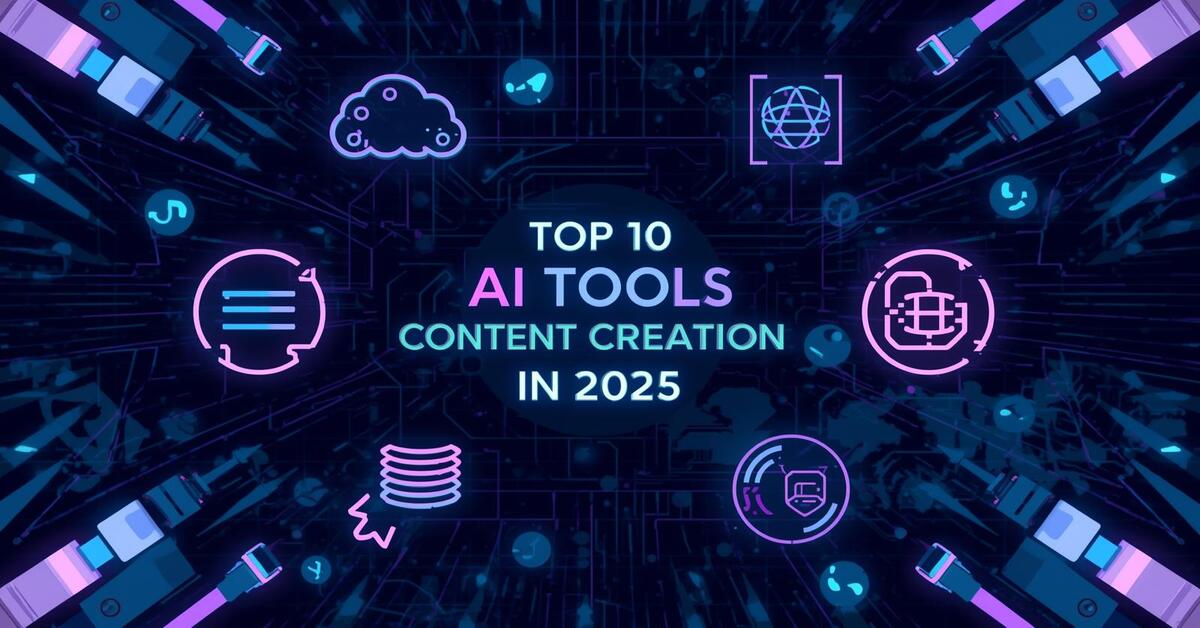


Add a Comment